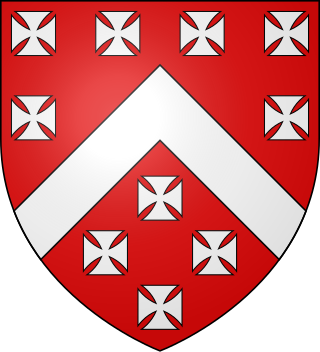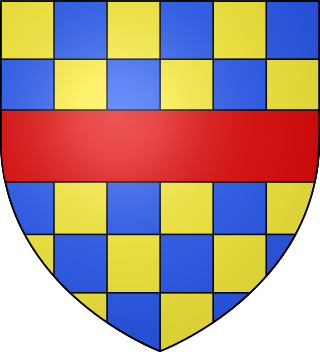
The feudal barony of Clifford (or Honour of Clifford) was a feudal barony with its caput baroniae at Clifford Castle in Herefordshire, England.

The feudal barony of Clifford (or Honour of Clifford) was a feudal barony with its caput baroniae at Clifford Castle in Herefordshire, England.
The Domesday Book of 1086 records that Clifford Castle was then held by Ralph de Tony (d.1102) [1] (alias de Tosny, Tosni, etc.), feudal baron of Flamstead in Hertfordshire. [2] It had been built by his brother-in-law William FitzOsbern, 1st Earl of Hereford (d.1071). William FitzOsbern was the husband of Adeliza de Tosny, daughter of Roger I of Tosny and sister of Ralph de Tony (d.1102).
At some time before 1127 the barony passed by means unexplained to Richard FitzPons (died 1138). [4] Richard was the brother and heir of Drogo FitzPons, a tenant of estates in Herefordshire listed in the Domesday Book. Richard married Maud de Gloucester, daughter of Walter of Gloucester (died c. 1129) and sister of Miles of Gloucester, 1st Earl of Hereford. [5] The son and heir of Richard FitzPons took the surname de Clifford after his father's barony (or due to his possible place of birth at Clifford Castle),[ citation needed ] as Walter de Clifford (died 1190).
He was succeeded by Richard de Clifford (died 1199), who died childless, and was succeeded by Walter de Clifford (died 1221), probably his brother. [6] His eldest son Walter de Clifford (died 1263) succeeded to the barony, but leaving no male children the barony descended via his daughter, see below. Walter's younger son however was Roger de Clifford (died 1231) of Tenbury, who founded his own long-lived line of the Clifford family, later feudal barons of Appleby and feudal barons of Skipton, Baron de Clifford (1299), Earl of Cumberland (1525), Baron Clifford (1628) and Baron Clifford of Chudleigh (1672), which last title survives in 2015, borne by his direct male descendant, seated at Ugbrooke Park in Devon.
Walter de Clifford (died 1263), heir to his father in the feudal barony of Clifford, married Margaret, the daughter of Prince Llywelyn ab Iorwerth of Wales, by whom he left a daughter and sole heiress Maud de Clifford (d.1282/5), who married firstly William Longespée (d.1257), grandson of William Longespée, 3rd Earl of Salisbury, and secondly John Giffard (d.1299) of Elston in Wiltshire, who held the barony jure uxoris. [7] Maud de Clifford's daughter and sole heiress, by her 1st husband William Longespée, was Margaret Longespée (d.1306/10), de jure Countess of Salisbury, who regained possession of the barony following the death of her step-father John Giffard in 1299. She married Henry de Lacy, 3rd Earl of Lincoln (d.1311), feudal baron of Skipton. In 1310 the barony of Skipton was granted by the king to the junior de Clifford line, in the person of Robert de Clifford, 1st Baron de Clifford (d.1314), seated at Appleby Castle in Westmorland. Margaret Longespée's daughter and sole heiress was Alice de Lacy (d.1348), who died childless, having married three times: firstly to Thomas, Earl of Lancaster (d.1322), secondly to Ebulo Lestrange (1335) and thirdly to Hugh de Frene (d.1336). [8] Clifford Castle was destroyed in 1402 by Welsh forces during the rebellion of Owain Glyndŵr.

Henry de Bohun, 1st Earl of Hereford of Pleshy Castle in Essex, was an Anglo-Norman nobleman who became Hereditary Constable of England from 1199.

The title Baron Berkeley originated as a feudal title and was subsequently created twice in the Peerage of England by writ. It was first granted by writ to Thomas de Berkeley, 1st Baron Berkeley (1245–1321), 6th feudal Baron Berkeley, in 1295, but the title of that creation became extinct at the death of his great-great-grandson, the fifth Baron by writ, when no male heirs to the barony by writ remained, although the feudal barony continued. The next creation by writ was in 1421, for the last baron's nephew and heir James Berkeley. His son and successor William was created Viscount Berkeley in 1481, Earl of Nottingham in 1483, and Marquess of Berkeley in 1488. He had no surviving male issue, so the Marquessate and his other non-inherited titles became extinct on his death in 1491, whilst the barony passed de jure to his younger brother Maurice. However, William had disinherited Maurice because he considered him to have brought shame on the noble House of Berkeley by marrying beneath his status to Isabel, daughter of Philip Mead of Wraxhall, an Alderman and Mayor of Bristol. Instead, he bequeathed the castle, lands and lordships comprising the Barony of Berkeley to King Henry VII and his heirs male, failing which to descend to William's own rightful heirs. Thus on the death of King Edward VI in 1553, Henry VII's unmarried grandson, the Berkeley inheritance returned to the family. Therefore, Maurice and his descendants from 1492 to 1553 were de jure barons only, until the return of the title to the senior heir Henry, becoming de facto 7th Baron in 1553. Upon his death he was succeeded by his relative George Harding.

Baron Clifford of Chudleigh, of Chudleigh in the County of Devon, is a title in the Peerage of England. It was created in 1672 for Thomas Clifford. The title was created as "Clifford of Chudleigh" rather than simply "Clifford" to differentiate it from several other Clifford Baronies previously created for members of this ancient family, including the Barony of de Clifford (1299), which is extant but now held by a branch line of the Russell family, having inherited through several female lines.
Richard de Clare, 3rd Earl of Hertford, feudal baron of Clare in Suffolk, and lord of Tonbridge in Kent and of Cardigan in Wales, was a powerful Anglo-Norman nobleman with vast landholdings in England and Wales.

Robert de Clifford, 1st Baron de Clifford, of Appleby Castle, Westmorland, feudal baron of Appleby and feudal baron of Skipton in Yorkshire, was an English soldier who became 1st Lord Warden of the Marches, responsible for defending the English border with Scotland.

Clifford Castle is a ruined castle in the village of Clifford which lies 2.5 miles to the north-east of Hay-on-Wye in the Wye Valley in Herefordshire, England. It was the caput of the feudal barony of Clifford, a Marcher Lordship. The castle stands in the grounds of a private house and is only open to the public on certain days of the year.

Henry de Lacy, Earl of Lincoln, Baron of Pontefract, Lord of Bowland, Baron of Halton and hereditary Constable of Chester, was an English nobleman and confidant of King Edward I. He served Edward in Wales, France, and Scotland, both as a soldier and a diplomat. Through his mother he was a great-grandson of Amadeus IV, Count of Savoy. He is the addressee, or joint composer, of a poem by Walter of Bibbesworth about crusading, La pleinte par entre missire Henry de Lacy et sire Wauter de Bybelesworthe pur la croiserie en la terre seinte.
Walter de Clifford (1113–1190) was an Anglo-Norman Marcher Lord of Bronllys Castle on the Welsh border, and was feudal baron of Clifford, seated at Clifford Castle in Herefordshire.
Robert de Stafford was an Anglo-Norman nobleman, the first feudal baron of Stafford in Staffordshire in England, where he built as his seat Stafford Castle. His many landholdings are listed in the Domesday Book of 1086.

Walter de Clifford feudal baron of Clifford in Herefordshire, was a Welsh Marcher Lord during the reign of King John (1199–1216).

The House of Tosny was an important noble family in 10th and 11th century Normandy, though it did not include any comtes or vicomtes. Its founder was Raoul I of Tosny.
Ela of Salisbury, 3rd Countess of Salisbury was an English peeress. She succeeded to the title in her own right in 1196 upon the death of her father, William FitzPatrick, 2nd Earl of Salisbury.

William II de Cantilupe, 2nd feudal baron of Eaton Bray in Bedfordshire, was an Anglo-Norman magnate.

The feudal barony of Bampton was one of eight feudal baronies in Devonshire which existed during the mediaeval era, and had its caput at Bampton Castle within the manor of Bampton.

The feudal barony of Okehampton was a very large feudal barony, the largest mediaeval fiefdom in the county of Devon, England, whose caput was Okehampton Castle and manor. It was one of eight feudal baronies in Devonshire which existed during the mediaeval era.
The feudal barony of Gloucester or Honour of Gloucester was one of the largest of the mediaeval English feudal baronies in 1166, comprising 279 knight's fees, or manors. The constituent landholdings were spread over many counties. The location of the caput at Gloucester is not certain as Gloucester Castle appears to have been a royal castle, but it is known that the baronial court was held at Bristol in Gloucestershire.

The Domesday Book of 1086 lists in the following order the tenants-in-chief in Devonshire of King William the Conqueror:
The feudal barony of Curry Mallet was an English feudal barony with its caput at Curry Mallet Castle in Somerset, about 7 miles east of Taunton.

The feudal barony of Appleby was a feudal barony with its caput at Appleby Castle in Appleby, Westmorland, England.

The Constable of Chester was a mediaeval hereditary office held by the Barons of Halton. The functions of the Constable are unclear, possibly they related to the custody of Chester Castle, as was the main function of most mediaeval constables, but Sanders (1960) says the office-holder was constable for the entire County Palatine.